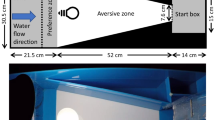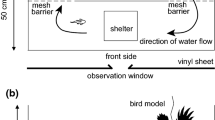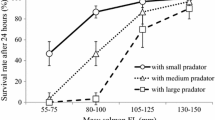Synopsis
The behavior of individual, juvenile pink salmon toward novel prey (Artemia salina) under laboratory conditions is described. Two aspects of predatory behavior, namely latency time to initial prey-capture attempt and prey-capture success, are quantified in relation to chronological age and feeding experience. Initially, mean latency time declined slightly with increasing age up to Day 19 (post-emergence from gravel), but increased sharply to an asymptote with further aging. Mean percentage capture success gradually increased from 7.88% on Day 1 to 92.9% on Day 45. Prior feeding experience on the prey resulted in a decline (to a stable level) in mean latency time in experienced fish compared to control fish. Mean percentage capture success was not significantly altered by prior feeding experience on the prey.
Similar content being viewed by others
References cited
Beukema, J. J. 1968. Predation by the three-spined stickle-back (Gasterosteus aculeatus L): The influence of hunger and experience. Behaviour 30: 1–126.
Blaxter, J. H. S. & M. Staines. 1971. Food searching potential in marine fish larvae. pp. 467–485. In: D. J. Crisp (ed.) Fourth European marine biology symposium, Cambridge University, Cambridge.
Braum, E. 1967. The survival of fish larvae in reference to their feeding behaviour and the food supply, pp. 113–131. In: S. D. Gerking (ed.) The biological basis of freshwater fish production. Blackwell Sci. Publ. Oxford.
Bryan, J. E. 1973. Feeding history, parental stock, and food selection in rainbow trout. Behaviour 45: 123–153.
Coppinger, R. P. 1969. The effect of experience and novelty on avian feeding behavior with references to the evolution of warning coloration in butterflies. Part I: Reactions of wild-caught adult blue jays to novel insects. Behaviour 35: 45–60.
Curio, E. 1976. The ethology of predation. Zoophysiology and Ecology, Vol. 7. Springer-Verlag, New York, 250 pp.
Davies, N. B. 1976. Parental care and the transition to independent feeding in the young Spotted Flycatcher (Muscicapa striata). Behaviour 59: 280–295.
Godin, J.-G. J., & M. Sankurathri. 1977. A comparison of the relative variability of wet and dry weights of young pink salmon (Oncorhynchus gorbuscha Walbaum). Fish. Mar. Serv. Res. Dev. Tech. Rep. 702, 8 pp.
Hart, J. L. 1973. Pacific fishes of Canada. Fish. Res. Board Can. Bull. 180, 740 pp.
Hogan, J. A. 1965. An experimental study of conflict and fear: An analysis of behavior of young chicks toward a mealworm I. The behavior of chicks which do not eat the mealworm. Behaviour 25: 45–97.
Hunter, J. R. 1972. Swimming and feeding behavior of larval anchovy, Engraulis mordax. U.S. Fish Wildl. Serv. Fish. Bull. 70: 821–838.
Keenleyside, M. H. A. 1955. Some aspects of the schooling behaviour of fish. Behaviour 8: 183–248.
Krebs, J. R. 1973. Behavioral aspects of predation, pp. 73–111. In: P. P. G. Bateson and P. H. Klopfer (ed.) Perspectives in ethology, Plenum Press, New York.
Nyberg, D. W. 1971. Prey capture in the largemouth bass. Amer. Midl. Nat. 86: 128–144.
Polsky, R. H. 1977. The ontogeny of predatory behaviour in the golden hamster (Mesocricetus a. auratus) I. The influence of age and experience. Behaviour 61: 26–57.
Radakov, D. V. 1973. Schooling in the ecology of fish. (Transl. from Russian by H. Mills). Israel Progr. for Sci. Transl Wiley and Sons, New York. 173 pp.
Rosenthal, H. 1969. Untersuchungen über das Beutefangverhalten bei Larven des Herings Clupea harengus. Marine Biology 3: 208–221.
Sokal, R R., & F. J. Rohlf. 1969. Biometry. The principles and practice of statistics in biological research. Freeman and Co., San Francisco. 776 pp.
Twongo, T. K. 1975. Development of feeding in the hatchery rainbow trout Salmo gairdneri Richardson. Ph.D. Thesis, University of Guelph, Guelph, Ontario. 119 pp.
Ware, D. M. 1971. Predation by rainbow trout (Salmo gairdneri): The effect of experience. J. Fish. Res. Board Can. 28: 1847–1852.
Author information
Authors and Affiliations
Rights and permissions
About this article
Cite this article
Godin, JG.J. Behavior of juvenile pink salmon (Oncorhynchus gorbuscha Walbaum) toward novel prey: influence of ontogeny and experience. Environ Biol Fish 3, 261–266 (1978). https://doi.org/10.1007/BF00001451
Received:
Accepted:
Issue Date:
DOI: https://doi.org/10.1007/BF00001451




